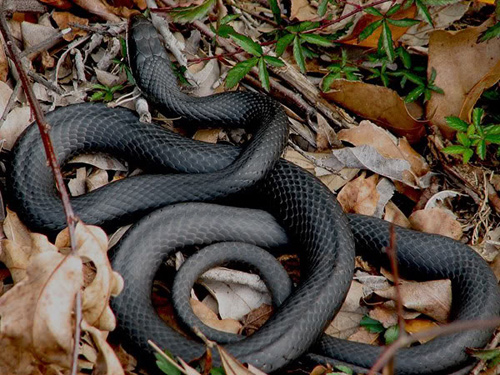The northern black racer is a large snake with a solid black body and a blue-gray belly. The body is cylindrical and the head is not much wider than the body. The scales are smooth, giving the snake a glossy appearance. These snakes can be 33 to 65 inches long.
There are several black racer subspecies with ranges through different areas of the US. The range of the northern black racer is generally from southern Maine to eastern Ohio and south to northern South Carolina, northern Georgia, northern Alabama and northeastern Mississippi. Northern black racers inhabit all but the extreme northeastern corner of Connecticut. Their population has been declining from habitat loss.
Black racer habitat includes lightly wooded areas, open forest, felds, meadows, powerline cuts and roadsides.
Mating season is in April or May in New England. Females will lay 16 or 17 eggs in sheltered areas such as under rotting stumps or under stones. She does not care for her eggs, but leaves them where she lays them and goes off about her business. The baby snakes use a special "egg tooth" to hatch out of their eggs in late summer or early fall. The young are light gray with brown blotches.
Northern black racers are fast-moving snakes and are out hunting during the daytime. They hibernate in the winter beginning about late October and can emerge in mid March. They often migrate to upslope dens to hibernate and will bask outside of the den for weeks beforehand. Snakes cannot regulate their body temperature internally and warm themselves in the sun. Dens in rock crevices or old burrows are generally used, and black racers often den communally. They can share winter dens with other black racers or with other snake species. They will often use the same den for years.
Northern Black racers are active hunters and eat insects, frogs, toads, small birds and small mammals. They pursue prey and swallow them whole. Although coils may be used to hold prey to the ground, they do not kill by constriction.
Northern black racers will try to avoid humans. They will often slither rapidly towards the nearest crevice or burrow if approached. Sometimes that bolt hole might be in the direction of an approaching human and this sometimes leads people to believe a racer is chasing them. In reality, it just wants to hide. They can vibrate their tails, relatively slowly, when alarmed. If cornered, a black racer will raise its head and strike, but their bite can't get through heavy clothes or boots. They are not venomous. They will produce musk, defecate and bite if handled.
To avoid trouble, don't bother or approach snakes, and watch where you step. If you see a dangerous snake, move away slowly. They want nothing more than to be left alone.
The northern black racer is often confused with the eastern ratsnake.
